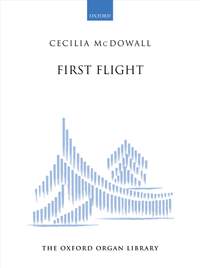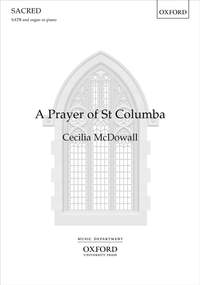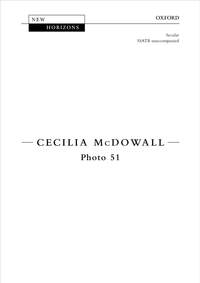Interview,
Cecilia McDowall at 70
 Composer Cecilia McDowall is one of the most immediately recognisable names in British choral composition – no small feat, given the country's extensive tradition of choral performance and writing – with a style that's been consistently praised for its clarity and immediacy. Her career has seen her draw extensively on extra-musical influences, from BBC Radio 4's well-loved Shipping Forecast to the pioneering cross-channel flight of Harriet Quimby in 1913 and, more recently, the biography of a Kurdish refugee from Kobanî, Syria.
Composer Cecilia McDowall is one of the most immediately recognisable names in British choral composition – no small feat, given the country's extensive tradition of choral performance and writing – with a style that's been consistently praised for its clarity and immediacy. Her career has seen her draw extensively on extra-musical influences, from BBC Radio 4's well-loved Shipping Forecast to the pioneering cross-channel flight of Harriet Quimby in 1913 and, more recently, the biography of a Kurdish refugee from Kobanî, Syria.
McDowall's most recent publications with the Oxford University Press continue this trend, taking inspiration from the epoch-making Apollo Moon landings and the breakthrough image 'Photo 51' that helped chemist Rosalind Franklin to lay the foundations for identifying the structure of DNA, as well as the text of a prayer by the Irish saint Columba. Her impact and significance as a composer is celebrated by a recent collection of her choral works recorded by Stephen Layton and the choir of Trinity College, Cambridge.
I spoke to Cecilia about her relationship with the voice as an 'instrument', and how she approaches the task of composition.
Paul Conway observes in the programme-notes to this album that “music for the voice occupies a central position” in your work as a composer. What is it about the voice that appeals to you so uniquely?
I enjoy writing for all combinations of instruments, orchestral, chamber, instrumental, but I do have a particular interest in writing for the voice. Perhaps this comes from my years of choral singing with both small and large ensembles and from experiencing the rich choral repertoire from within, as a singer. And then of course, there is the text. I find great pleasure in looking for good words to set and thinking about the context of the commission, where it will be performed and who by. There is, of course, such a wonderful wealth of words to choose from but I also love working with poets and librettists on new texts and finding interesting ways to fashion an idea.
Who would you say were the main influences on your style – and how much do you think your compositional voice has changed over your career?
I do find it hard to define how my style of writing has been influenced over the years but I would say my choral works have some roots in the glorious Renaissance period. If I were to pick out one composer, who always surprises and intrigues me, it would be Thomas Tallis so it is very likely my creative thinking will have been affected by what I have heard and admired. It is difficult for me to assess how my style has changed – I feel there are many fine minds better able to hear my work objectively.
This album comprises sacred works, though your vocal and choral output comprises a huge amount of secular music as well. Is there any difference in the way you approach sacred and non-sacred compositions?
My approach to writing sacred or secular music is really guided by the commissioning brief; where it will be performed and who will be performing the work. Possibly more relevant, as to how I make decisions on what to write, will be whether the work is for amateur or for professional/semi-professional singers. But the occasion, for which the new work is intended, also gives me direction. As I’ve mentioned already, the text is vital. I often explore, particularly with secular works, the background of my idea so as to bring as much depth to the perspective as I can. On this disc Standing as I do before God is probably the best example of this process.
The settings of the O Antiphons for solo organ, naturally, lack any way to articulate the texts of the antiphons directly. How do you approach the seemingly paradoxical task of responding wordlessly to a textual starting-point?
In the case of my O Antiphon Sequence every movement has a clearly designated instruction in the score at the start. I took a short phrase from the text of each of the seven O Antiphons and endeavoured to characterise these short movements using the text as inspiration. In addition the O Antiphon plainchant appears in each of the seven sections.
As well as this new album of sacred choral works, some of your pieces have recently been published for the first time - A Prayer of St Columba, and Photo 51 commemorating the pioneering chemist Rosalind Franklin, with First Flight and the upcoming God be with us hot on their heels. Can you tell us a bit about your relationship with the Oxford University Press?
In 2010 Oxford University Press invited me to become a ‘house’ composer, a partnership I have greatly valued over the years. They publish not only my choral music but some of my orchestral, chamber, vocal and organ music. It is always a pleasure to work with the Music Department.
Trinity College Cambridge, Stephen Layton
Available Formats: CD, MP3, FLAC, Hi-Res FLAC, Hi-Res+ FLAC
This inventive work, composed in 2019, owes its title to that year's two great anniversaries connected to manned flight: the 50th anniversary of the first moon landing and the 500th anniversary of the death of Leonardo da Vinci. A range of highly effective textures and atmospheric harmonies takes us on a journey towards a gloriously affirmative D major ending.
Available Format: Sheet Music
A Prayer of St Columba is an expressive and emotive anthem with appealing, arching melodies underpinned by a sparkling organ part.
Available Format: Sheet Music
Composed for International Women's Day, this mesmerizing piece celebrates the centenary of Rosalind Franklin and sets her own words with additional text by the poet Sean Street.
Available Format: Sheet Music
This uplifting anthem sets the Invocation text from Carmina Gadelica. McDowall's beautiful melodies flow and intertwine, decorated by scotch snaps that reflect the text's origin.
Available Format: Sheet Music







